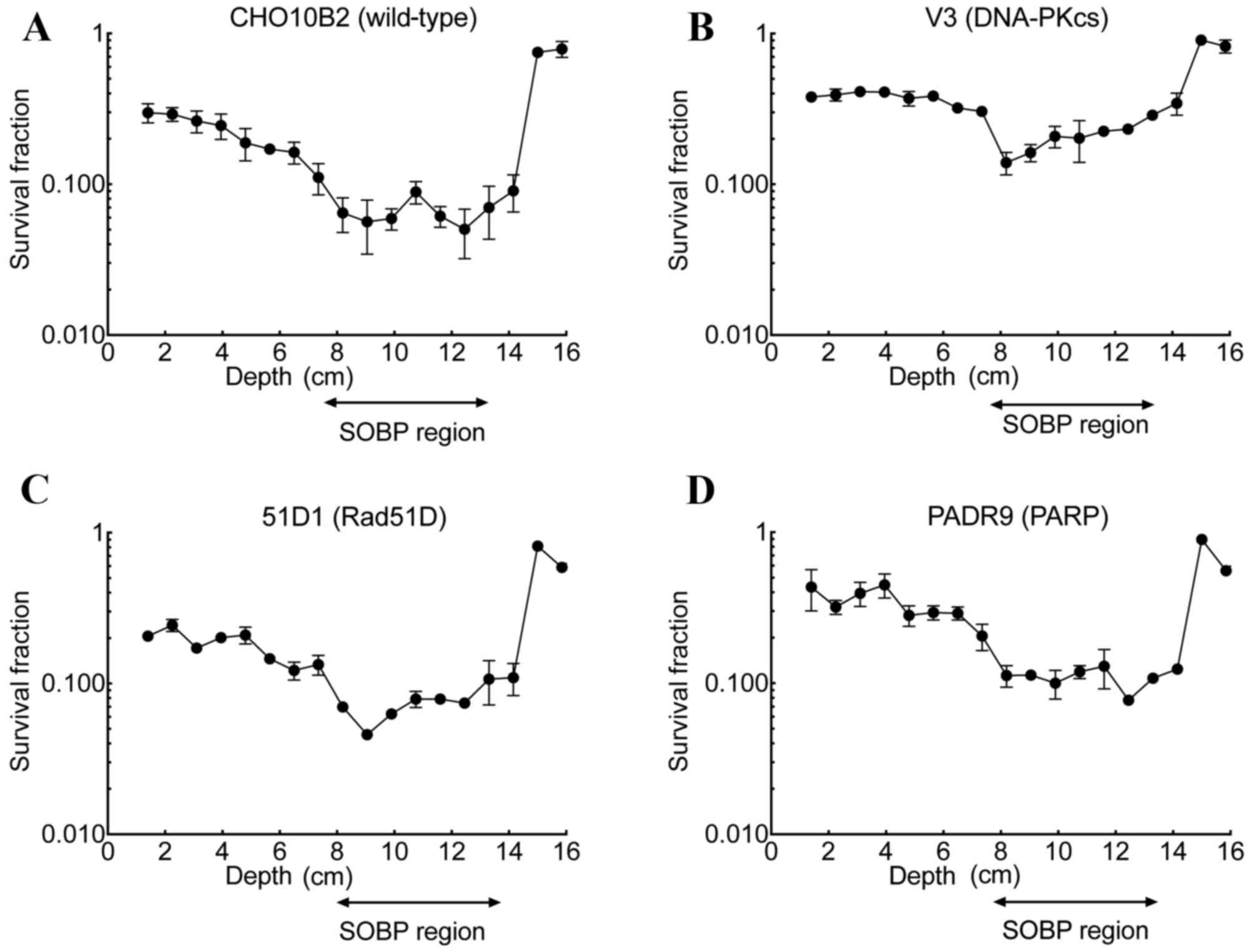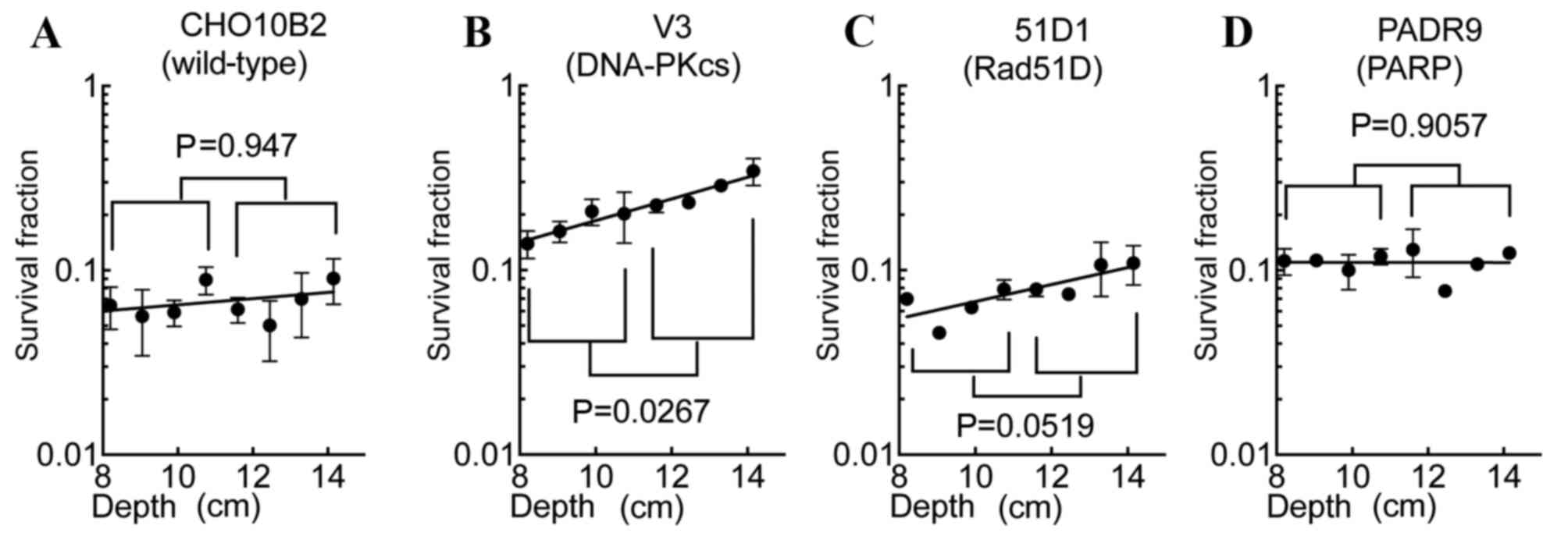|
1
|
Durante M and Loeffler JS: Charged
particles in radiation oncology. Nat Rev Clin Oncol. 7:37–43. 2010.
View Article : Google Scholar : PubMed/NCBI
|
|
2
|
Marx V: Cancer treatment: Sharp shooters.
Nature. 508:133–138. 2014. View
Article : Google Scholar : PubMed/NCBI
|
|
3
|
Okayasu R: Repair of DNA damage induced by
accelerated heavy ions-A mini review. Int J Cancer. 130:991–1000.
2012. View Article : Google Scholar : PubMed/NCBI
|
|
4
|
Hirayama R, Furusawa Y, Fukawa T and Ando
K: Repair Kinetics of DNA-DSB induced by X-rays or C Ions under
oxic and hypoxic conditions. J Radiat Res. 46:325–332. 2005.
View Article : Google Scholar : PubMed/NCBI
|
|
5
|
Belli M, Bettega D, Calzolari P, Cherubini
R, Cuttone G, Durante M, Esposito G, Furusawa Y, Gerardi S,
Gialanella G, et al: Effectiveness of monoenergetic and spread-out
bragg peak carbon-ions for inactivation of various normal and
tumour human cell lines. J Radiat Res. 49:597–607. 2008. View Article : Google Scholar : PubMed/NCBI
|
|
6
|
Okayasu R, Okada M, Okabe A, Noguchi M,
Takakura K and Takahashi S: Repair of DNA damage induced by
accelerated heavy ions in mammalian cells proficient and deficient
in the non-homologous end-joining pathway. Radiat Res. 165:59–67.
2006. View
Article : Google Scholar : PubMed/NCBI
|
|
7
|
Yajima H, Fujisawa H, Nakajima NI,
Hirakawa H, Jeggo PA, Okayasu R and Fujimori A: The complexity of
DNA double strand breaks is a critical factor enhancing
end-resection. DNA Repair (Amst). 12:936–946. 2013. View Article : Google Scholar : PubMed/NCBI
|
|
8
|
Benjamin RC and Gill DM: Poly(ADP-ribose)
synthesis in vitro programmed by damaged DNA. A comparison of DNA
molecules containing different types of strand breaks. J Biol Chem.
255:10502–10508. 1980.PubMed/NCBI
|
|
9
|
Benjamin RC and Gill DM: ADP-ribosylation
in mammalian cell ghosts. Dependence of poly(ADP-ribose) synthesis
on strand breakage in DNA. J Biol Chem. 255:10493–10501.
1980.PubMed/NCBI
|
|
10
|
Genet SC, Maeda J, Fujisawa H, Yurkon CR,
Fujii Y, Romero AM, Genik PC, Fujimori A, Kitamura H and Kato TA:
Comparison of cellular lethality in DNA repair-proficient or
-deficient cell lines resulting from exposure to 70 MeV/n protons
or 290 MeV/n C ions. Oncol Rep. 28:1591–1596. 2012.PubMed/NCBI
|
|
11
|
Fujisawa H, Genik PC, Kitamura H, Fujimori
A, Uesaka M and Kato TA: Comparison of human chordoma cell-kill for
290 MeV/n C ions versus 70 MeV protons in vitro. Radiat Oncol.
8:912013. View Article : Google Scholar : PubMed/NCBI
|
|
12
|
Whitmore GF, Varghese AJ and Gulyas S:
Cell cycle responses of two X-ray sensitive mutants defective in
DNA repair. Int J Radiat Biol. 56:657–665. 1989. View Article : Google Scholar : PubMed/NCBI
|
|
13
|
MacLaren RA, Witmer MV, Richardson E and
Stamato TD: Isolation of Chinese hamster ovary cells with reduced
poly(ADP-ribose) polymerase activity. Mutat Res. 231:265–274. 1990.
View Article : Google Scholar : PubMed/NCBI
|
|
14
|
Witmer MV, Aboul-Ela N, Jacobson MK and
Stamato TD: Increased sensitivity to DNA-alkylating agents in CHO
mutants with decreased poly(ADP-ribose) polymerase activity. Mutat
Res. 314:249–260. 1994. View Article : Google Scholar : PubMed/NCBI
|
|
15
|
Hinz JM, Tebbs RS, Wilson PF, Nham PB,
Salazar EP, Nagasawa H, Urbin SS, Bedford JS and Thompson LH:
Repression of mutagenesis by Rad51D-mediated homologous
recombination. Nucleic Acids Res. 34:1358–1368. 2006. View Article : Google Scholar : PubMed/NCBI
|
|
16
|
Sunada S, Fujisawa H, Cartwright IM, Maeda
J, Brents CA, Mizuno K, Aizawa Y, Kato TA and Uesaka M:
Monoglucosyl-rutin as a potential radioprotector in mammalian
cells. Mol Med Rep. 10:10–14. 2014.PubMed/NCBI
|
|
17
|
Mcmillan DD, Maeda J, Bell JJ, Genet MD,
Phoonswadi G, Mann KA, Kraft SL, Kitamura H, Fujimori A, Yoshii Y,
et al: Validation of 64 Cu-ATSM damaging DNA via high-LET Auger
electron emission. J Radiat Res. 56:784–791. 2015. View Article : Google Scholar : PubMed/NCBI
|
|
18
|
Maeda J, Cartwright IM, Haskins JS, Fujii
Y, Fujisawa H, Hirakawa H, Uesaka M, Kitamura H, Fujimori A, Thamm
DH and Kato TA: Relative biological effectiveness in canine
osteosarcoma cells irradiated with accelerated charged particles.
Oncol Lett. 12:1597–1601. 2016.PubMed/NCBI
|
|
19
|
Weyrather WK, Ritter S, Scholz M and Kraft
G: RBE for carbon track-segment irradiation in cell lines of
differing repair capacity. Int J Radiat Biol. 75:1357–1364. 1999.
View Article : Google Scholar : PubMed/NCBI
|
|
20
|
Beck C, Robert I, Reina-San-Martin B,
Schreiber V and Dantzer F: Poly(ADP-ribose) polymerases in
double-strand break repair: Focus on PARP1, PARP2 and PARP3. Exp
Cell Res. 329:18–25. 2014. View Article : Google Scholar : PubMed/NCBI
|
|
21
|
Urushibara A, Shikazono N, O'Neill P,
Fujii K, Wada S and Yokoya A: LET dependence of the yield of
single-, double-strand breaks and base lesions in fully hydrated
plasmid DNA films by 4He(2+) ion irradiation. Int J Radiat Biol.
84:23–33. 2008. View Article : Google Scholar : PubMed/NCBI
|
|
22
|
Taucher-Scholz G and Kraft G: Influence of
radiation quality on the yield of DNA strand breaks in SV40 DNA
irradiated in solution. Radiat Res. 151:595–604. 1999. View Article : Google Scholar : PubMed/NCBI
|
|
23
|
Taucher-Scholz G, Stanton JA, Schneider M
and Kraft G: Induction of DNA breaks in SV40 by heavy ions. Adv
Space Res. 12:73–80. 1992. View Article : Google Scholar : PubMed/NCBI
|
|
24
|
Hirai T, Shirai H, Fujimori H, Okayasu R,
Sasai K and Masutani M: Radiosensitization effect of
poly(ADP-ribose) polymerase inhibition in cells exposed to low and
high liner energy transfer radiation. Cancer Sci. 103:1045–1050.
2012. View Article : Google Scholar : PubMed/NCBI
|
|
25
|
Kagawa K, Murakami M, Hishikawa Y, Abe M,
Akagi T, Yanou T, Kagiya G, Furusawa Y, Ando K, Nojima K, et al:
Preclinical biological assessment of proton and carbon ion beams at
Hyogo ion beam medical center. Int J Radiat Oncol Biol Phys.
54:928–938. 2002. View Article : Google Scholar : PubMed/NCBI
|













